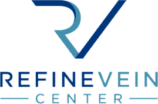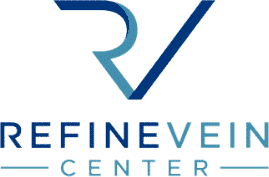Two of the most common vein issues patients ask about at Refine Vein Center are spider veins and varicose veins. Though both involve visible veins, they differ significantly in appearance, causes, and treatments. Understanding those differences is crucial for choosing the right path to healthier, more comfortable veins.
What Are Spider Veins?
Spider veins (also known as telangiectasia) are small, thread-like veins, usually less than 2–3 mm across, visible just under the surface of the skin. They often appear red, blue, or purple and frequently form in branching patterns reminiscent of a spider web.
You might notice spider veins on the thighs, calves, ankles, and occasionally the face or chest, especially after sun exposure or trauma. While largely cosmetic, some people report mild symptoms like itching, throbbing, or restlessness in the legs.
What Are Varicose Veins?
Varicose veins are larger swollen, twisted veins, typically bluish or dark purple, often bulging and raised above the skin. The root cause is usually venous valve failure, which allows blood to pool, increasing pressure and distorting the vein.
Symptoms can be more pronounced than spider veins, including aching, heaviness, leg cramps (especially at night), swelling, itching or rash, skin darkening, and an overall sense of discomfort, especially after prolonged standing or sitting.
Varicose Veins vs. Spider Veins: Side-by-Side Comparison
| Spider Veins | Varicose Veins | |
| Size & Appearance | 0.5–3mm, red/blue spider web pattern | Larger (>3mm), bulging, twisted, rope-like |
| Depth | Superficial, capillary level | Deeper superficial veins |
| Symptoms | Usually cosmetic only, occasional itching or aching | Pain, heaviness, cramping, swelling, skin changes |
| Cause | Hormones, sun, trauma, minor capillary damage | Valve dysfunction, venous insufficiency |
| Risk Factors | Female sex, hormones, sun, injury | Age, family history, obesity, pregnancy, prolonged standing |
| Health Concern | Typically benign | May lead to ulcers, bleeding, thrombosis |
| Treatment Focus | Sclerotherapy for surface veins | Ablation, sclerotherapy |
What Causes Each and What Raises Your Risk?
Spider Veins
Spider veins often result from hormonal changes (like pregnancy or menopause), sun exposure, minor trauma, or heredity. Though they can be linked to mild reflux, they also arise independently of major vein dysfunction.
Varicose Veins
These primarily arise from chronic venous insufficiency: when the one-way valves inside leg veins become weakened or damaged, leading to blood pooling and vein enlargement. Risk factors include:
- Age (valves weaken over time)
- Family history
- Pregnancy (hormonal shifts and increased blood volume)
- Obesity
- Prolonged sitting or standing
- Previous leg injuries
Treatment Options: How Are Spider Veins and Varicose Veins Managed Differently?
Spider Vein Treatments at Refine Vein Center
We offer surface sclerotherapy, the gold standard treatment for spider veins. A sclerosant is injected into the vein, causing it to collapse and redirect blood flow to healthier veins. This improves both appearance and minor symptoms like itching or throbbing.
Surface sclerotherapy is quick, minimally invasive, and typically doesn’t require any downtime for recovery.
Varicose Vein Treatments at Refine Vein Center
We treat the underlying reflux first, often using minimally invasive varicose vein treatments such as:
- Endovenous Laser Ablation (EVLA) or Radiofrequency Ablation (RFA) – Ultrasound-guided thermal energy seals the diseased vein, rerouting blood flow through healthy veins.
- Sclerotherapy – May be performed to treat residual branches.
Why Treat Varicose Veins First?
It’s crucial to address varicose veins before treating spider veins. Treating underlying reflux ensures reliable and longer-lasting results. Otherwise, spider veins may recur even after cosmetic treatment because pressure issues haven’t been resolved.
Preventative and Conservative Measures: What Can You Do?
Both conditions often benefit from the following methods of supportive self-care:
- Compression stockings help reduce swelling and improve blood flow, especially for varicose veins.
- Leg elevation helps relieve pressure and swelling.
- Exercise, particularly walking or swimming, keeps calf muscles active and supports venous return.
- Maintaining a healthy weight and avoiding prolonged sitting and standing.
These measures may ease symptoms but usually don’t completely eliminate visible veins.
When to See a Vein Specialist
Consider a consultation at Refine Vein Center if you experience:
- Bulging veins, pain, heaviness, swelling, or skin changes
- Bleeding from a visible vein
- Cosmetic concerns affecting confidence or comfort
We specialize in diagnosing and treating vein diseases. Our comprehensive approach, led by board-certified specialist Dr. J. Avery Reynolds, ensures a personalized plan based on ultrasound imaging and overall health status.
Why Choose Refine Vein Center?
- Expert Care – Board-certified physician experienced in both varicose and spider vein treatments.
- Advanced, Minimally Invasive Treatments – Ultrasound-guided procedures like sclerotherapy and ablation.
- Patient-Centered Focus – Tailored treatment plans and supportive post-procedure care.
Spider Veins vs. Varicose Veins: Summary
- Spider Veins: small, superficial, cosmetic, often treated with sclerotherapy.
- Varicose Veins: larger, deeper, potentially symptomatic or dangerous.
- Treat varicose veins first to address root causes before cosmetic treatments.
- Conservative measures (compression, lifestyle changes, etc.) support both conditions.
- At Refine Vein Center, all treatments are customized, effective, and minimally invasive.
If you’re uncertain where to begin, Refine Vein Center offers consultations to evaluate your vein health and recommend the best next steps.
Don’t let spider veins or varicose veins hold you back—take the first step and schedule your consultation today.



